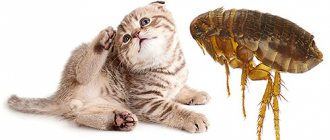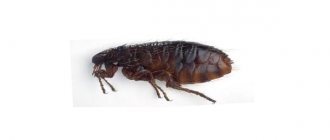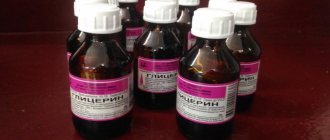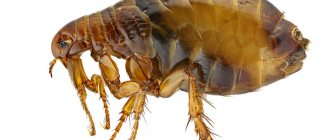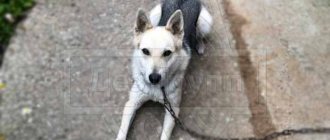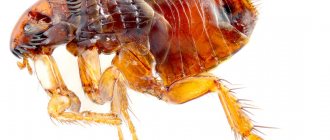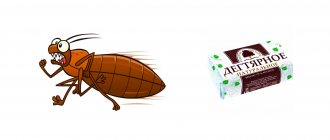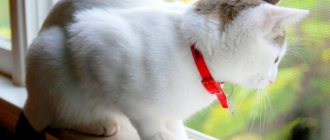Using bleach for fleas. Fighting parasites at home. What effect does bleach have on fleas? Are parasites afraid of the smell of bleach? How to carry out treatment in residential premises. What determines the effectiveness of this method? Security measures.
Flea infestation in residential areas is a fairly serious problem that needs to be solved as quickly as possible. After all, parasites multiply very quickly and after a short period of time a huge colony will live in the apartment, which is quite difficult to cope with. These small bloodsuckers inflict painful bites, after which the affected areas itch very much, in addition, infection with various infections is possible.
Now there is a large selection of specialized means for combating parasites, but many prefer to use traditional methods, one of which is bleach for fleas. Let’s look at this method in more detail and find out whether it can cope with parasites.
Safe pest control for pets
It is a great happiness to have a beloved pet in your home, but they are susceptible to disease as often as humans, and the presence of fleas causes them particular discomfort.
For pets, we recommend choosing the safest pest control product, for example:
- Butox, a non-toxic product, is safe for both small children and pets. Available in ampoules of 10 ml, sold in any veterinary clinic. Before use, concentrated Butox should be diluted with warm water. The prepared solution is used to treat the entire area of the apartment, including furniture, carpets, and rugs.
- Monitor lizard, non-toxic, safe for pets.
- Stronghold is a very popular drug among pet lovers. They act quickly, you just need to apply it to your pet’s dry fur. Contains Selamectin, which can infect flea eggs, scabies mites and a number of helminthic infestations. Stronghold remains effective for two weeks after application
- Finpronil, the drug has a paralyzing effect on the nervous system of the parasite. It is used to treat the animal's fur; sometimes pets become restless because it burns the skin a little.
- Selamectin, a synthetic drug, acts almost instantly on parasites. Preparations made on its basis are not recommended for use on small and sick animals.
- Inspector, available in the form of alcohol-based drops, the main active ingredient is moxidectin. The inspector has a paralyzing effect on the nerve cells and receptors of the insect, thereby destroying it.
- Advocate is an excellent insecticidal agent, Advocate acts not only on fleas, the drug destroys helminth eggs laid on the hair of animals. Available in the form of drops, applied only to dry skin, the result of use is noticeable after the first use.
- Frontline is intended for dogs only and is also applied to the skin in the form of drops. Since Frontline is insectoacaricidal, it is recommended to use it not only to combat bloodsuckers, but also to destroy various ticks and lice-eaters. Sold in a veterinary pharmacy, in the form of a plastic pipette with a break-off tip, applied behind the ears, on the dog’s spine. The medicine has a detrimental effect on the nerve cells of insects, leading to paralysis and death in a matter of hours.
- Advantix, the product is produced by the German company. Advantix drops are a powerful repellent. Repels most ectoparasites from your pet. The distinctive property of the repellent is that before the parasite has time to land on the animal’s fur, it dies. Advantix also has a detrimental effect on the larvae and eggs of parasites. Ideal for treating an animal's sleeping area.
- Practitioner is an innovative means for exterminating various insects. The drug Praktik is available in the form of oil drops and is applied to the animal’s fur. It has a wide range of protective properties, acts not only on fleas, but also on lice, scabies mites, and destroys mites.
- FLI spray has a detrimental effect on dust mites and fleas. Due to its unique composition, it is used in cars to reduce the level of dust allergens. FLI spray is also used to treat living quarters and animal bedding. The drug is suitable for fleas and their eggs. The effectiveness of the treatment lasts up to 2 months.
For each of the above drugs, instructions are given for fleas; you should read them carefully, study all the indications and contraindications when using the chosen product.
Are they afraid of the smell?
Answering the question whether fleas are afraid of the smell of bleach, it is worth noting that bloodsuckers have an excellent sense of smell. The product blocks the nervous system of the parasite, paralyzing it, so whiteness and fleas are incompatible.
With weak disinfection, bloodsuckers can leave the premises and find new housing, but if the work is taken seriously, then most of the individuals will die on the spot without having time to escape.
What smells are scary for fleas?
The smells of some plants and chemicals can repel adults.
Natural
Many herbs and trees have sharp, specific odors that are pleasant to our sense of smell, but unbearable to parasites. The arsenal of natural products consists of several items, so everyone can choose the following scent:
- anise;
- carnation;
- cedar;
- lavender;
- lemon and other citrus fruits;
- juniper;
- mint;
- pelargonium (geranium);
- tansy;
- sagebrush;
- rosemary;
- pine;
- thyme;
- garlic;
- eucalyptus.
Aromatic herbs are not able to destroy various forms of fleas - they serve as repellents, which may be ineffective if the insects are very hungry.
Chemical origin
The odors of some chemicals and building materials have a negative effect on blood-sucking parasites. In the fight against fleas you can use:
- fresh cement;
- putty;
- turpentine;
- petrol;
- paints and varnishes based on organic solvents.
Treating the premises against fleas.
It is undesirable to use aggressive and pungent-smelling chemicals in a residential building or apartment, because this can cause harm to people and animals. But the likelihood of getting rid of insects during repairs increases several times.
Another powerful remedy is bleach. This caustic substance has a triple effect: repels fleas, kills adults and larvae (paralyzes the nervous system and the functioning of all internal organs), disinfects treated surfaces
When working with bleach, you must act with extreme caution: it should not be used on upholstered furniture, textiles, or delicate surfaces. The best way to use bleach is to wash your floors regularly.
What plants repel parasites
Natural herbal remedies have proven effective in repelling fleas. Herbs must be used for a long time (The most effective herbs for killing fleas in an apartment). Fresh raw materials should be constantly added. Plants are placed around the entire perimeter of the rooms. It should be borne in mind that freshly harvested plants have a stronger effect than dried herbs. Fleas cannot tolerate the smell of the following plants:
- Sagebrush.
- Tansy.
- Mint.
- Carnation.
- Korostavnik.
- Citrus.
- Needles.
- Bay leaf.
- Geranium.
To wash animals and carry out wet cleaning, decoctions and infusions are made from thyme, lavender, celandine, and eucalyptus. A concentrated infusion of wormwood, celandine and pine needles has a special effect.
Advice! We recommend constantly tying a sprig of a fragrant plant to your cat or dog’s collar. The esters contained in herbs prevent the establishment of pests. In the fight against blood-sucking insects, a powder made from dried bark grass gives a good effect.
Probable habitats of fleas
The most common habitats for fleas in an apartment are:
- Carpeting. Most of all, these insects like products made from natural pile, where they feel very comfortable. Warm pile creates optimal conditions for the reproduction of blood-sucking insects.
- Pet bedding. Of course, if you don’t remove fleas from your pet in time, they won’t go away on their own. Since the animal sleeps most of the time, the likelihood of seeing a flea on its bedding is significantly greater than in any other place.
- Cushioned furniture. Since the habitats of these vile insects are located no higher than 1 meter from the floor, a comfortable soft sofa or chair will be the best place for them to stay.
- Bed sheets. Bed linen is the most convenient place for fleas to live. After all, most often fleas go hunting at night, when the owners are sleeping. Many people confuse flea bites with bedbug bites because they are so similar.
- Cloth. These little bloodsuckers especially love fur products, in which they are so comfortable to reproduce. Eggs and adults from the grass most often end up on clothes and shoes, so bringing an unwanted tenant into the house is not particularly difficult.
- Hard-to-reach places behind baseboards and in wall crevices. This is where fleas most often lay their eggs. After all, hard-to-reach places where people rarely look are the most carefree corners in the house for their children.
Most of all, these insects like products made from natural pile; they feel very comfortable there.
Effective chemicals against fleas
The best remedy for fleas is prevention and keeping your home clean. Regular washing of surfaces, vacuuming, ventilation and treatment with disinfectants greatly reduces the risk of an unpleasant neighborhood. But if you still have household fleas, chemical agents will help get rid of them; let’s look at the main ones.
Flea sprays
Insecticidal substances contained in aerosols affect the nervous system of the insect, leading to paralysis and death
At the moment, this is one of the fastest ways to deal with household fleas, however, you should be careful when using the aerosol, as most of them are toxic to humans and pets. Such products must be used strictly according to the instructions; processing must be carried out in stages.
- Before processing, wet cleaning is carried out and excess debris is removed in order to eliminate possible accumulations of larvae and adults.
- Furniture should be moved away from the walls and carpets should be removed.
- It is imperative to remove residents and pets from the apartment, preferably for a day.
- The aerosol is sprayed in areas of suspected accumulation (cracks, baseboards, doorways, seams on upholstered furniture).
- After treatment, close all doors and windows.
- After the time specified in the instructions, the apartment or private house is thoroughly ventilated, the carpets are vacuumed, and wet cleaning is done again.
Aerosols that have proven themselves are: Flee, Combat, Raid, Control Home Flea&Tick Killer, Clean House, Executioner, Raptor.
Solutions, emulsions and concentrates for fleas
Concentrates are diluted with water in accordance with the instructions, application occurs using a spray bottle (it is also convenient for them to treat surfaces with solutions and emulsions).
When applied, a film is formed, in contact with which insects die. The distinctive advantage of such products is that they do not require reapplication, as they have a long-lasting residual effect. The following received good reviews: Tsifoks, Get, Butox, Cucaracha, Tetrix.
Flea dusts and powders
Due to the nature of their application, powders and dusts are more effective in non-residential premises - warehouses, basements, attics. Such products have shown themselves especially well in places with a high degree of infestation due to the destruction of not only adult fleas, but also their larvae.
Folk remedies for fleas in the house
How to get rid of fleas in the house? Experienced housewives advise doing this with the help of herbs and decoctions. Very effective, and most importantly – safe for people and animals. Can be used in combination with chemicals or for prevention
But it is important to consider that the first option may take longer to get rid of uninvited “guests”
Fighting fleas in the house with folk remedies
- Salt.
Mix 200 g of salt and soda, treat carpets and furniture, and remove the residue with a vacuum cleaner. Repeat every 3-4 days until the insects disappear. - Citrus.
Scatter orange or lemon peels in corners, on window sills, and shelves. - Mixtures.
Mix garlic and yeast, sprinkle on corners, leave for a day. - Needles.
Scatter spruce needles on fleecy surfaces and remove them every other day. - Herbs.
Place bunches of calamus, mint and wormwood in corners and in cabinets. - Decoctions.
Prepare a composition of eucalyptus, wormwood and tansy in equal parts, brew with boiling water, leave for 3 hours. Treat surfaces in the house. - Essential oils.
Dilute lavender, mint and eucalyptus, spray in areas where fleas accumulate. - Spray.
Pour boiling water over the skins of lemons and oranges and leave overnight. Add citric acid. Spray on infected areas. You can replace the skins with juice or zest.
Wormwood for fleas in the house
Wormwood against fleas in the house is also very effective; its smell helps fight not only fleas, but also ants, cockroaches, and moths
But it is important to remember that herbs only repel insects, but do not destroy them. If the house is full of pests, you need stronger products
But wormwood can consolidate the effect or prevent fleas from entering the house.
Directions for use:
- Make bunches of dry grass and place them in corners where pests accumulate.
- Buy oil or tincture of wormwood, pour into glasses, place in corners and on window sills. You can treat animal hair with oil, but be sure to rinse it off afterwards.
Boric acid for fleas in the house
Boric acid is also often used for fleas. This is a powder in the form of crystals, it is sprinkled on carpets, furniture, floors, the product remains on the insects, and they themselves carry it around the house. To enhance the effect, you can mix the acid with wormwood or mint powder. The mixture must be kept for at least 12 hours, then removed or refreshed.
Ammonia for fleas in the house
If it is possible for all household members to leave the home for several hours, you can use ammonia against fleas. The product is very toxic, so it is advisable to close the house. The solution is added to the water for washing floors and placed in bowls in the corners of the rooms. If there are animals, soak their bedding in the solution.
Ingredients:
- Ammonia – 5-6 drops.
- Water – 500 ml.
Preparation:
- Mix the ingredients.
- Add to water for washing floors.
Tar soap for fleas in the house
Such an excellent remedy as tar soap has long been known to be very effective against fleas. The drug paralyzes the centers of the nervous system of insects. The soap is softened, whipped into foam, and poured into water for washing floors. The smell remains strong, so you need to leave the apartment for a couple of hours and then ventilate.
Soap is also used for bathing animals:
- Wet your pet's fur and lather it.
- Beat the foam, wrap it in cloth.
- Leave for 10 minutes, then rinse the wool thoroughly.
- Dry, comb out fleas and larvae.
Sagebrush
This is an ancient, proven folk remedy for fighting insects. To get rid of fleas, they hung freshly picked grass in the house, then learned how to obtain essential oil, the pungent smell of which repels insects. To this day, the tradition of using wormwood remains in demand.
Wormwood is found in tincture form, as freshly harvested plants, essential oil, or ground herb. Each of them is used as a folk remedy for fleas. It should be noted that the strong odors of plants do not kill, but only repel fleas.
Wormwood tincture for fleas
The product helps get rid of parasites and protect your family and pets from diseases carried by fleas. The tincture dissolves in water and is used to clean floors against fleas. It is also used to treat the hair of dogs and cats. The tincture is sold at the market or in a pharmacy. To prepare the tincture yourself, pour crushed dry wormwood with vodka and let it brew for two weeks.
Wormwood oil for fleas
Wormwood oil works by releasing aromas that repel fleas and other insects without killing them. The skin and fur of the animal are treated with wormwood oil, and bowls with oil are placed on the floor around the apartment.
Wormwood oil is available in pharmacies. To prepare this folk remedy yourself, pour dried crushed wormwood with olive oil in a small jar. Shake the mixture well and put it in a dark place for 10 days. After straining, the oil is ready for use.
Wormwood decoction for fleas
To prepare a decoction of wormwood at home
- Grind freshly harvested or dried herbs
- Place in a saucepan of boiling water and boil for 5 minutes
- Leave to cool
The resulting decoction is suitable for treating animals, as well as bedding, furniture, carpets and cleaning floors against fleas.
The insecticidal properties of wormwood are beyond doubt; it is used in agriculture, grown near potato and carrot fields to repel pests. So to combat seasonal flea infestations, you can grow mugwort in your yard or even inside your home.
But wormwood is a strong allergen, so be careful. For those who are prone to plant allergies, this folk remedy is not suitable. Do not use wormwood for medicinal purposes without consulting a doctor; for some, it causes unwanted reactions in the body.
Preventing fleas indoors
It is important not only to get rid of cat fleas, but also to prevent their reappearance in the apartment. To do this you need:
- Every 10-14 days, spray the ventilation openings, stairwells, door mats, and when living on the 1st-2nd floor, window sills and balconies with anti-parasite agents.
- To get rid of fleas from an animal, treat it with antiparasitic agents that provide long-term protection (Bars Forte, Beafar, Celandine, etc.), or buy an anti-flea collar.
- Vacuum your apartment at least once a week. This measure allows you to get rid of pupae and larvae in a timely manner. The dust container must be emptied after each cleaning.
- Wash clothes and bedding at the highest possible temperature.
- Residents of private houses should regularly mow the lawn. Short grass warms up well in the sun and becomes unattractive to cat fleas. Along the perimeter you can plant plants with a strong smell: tansy, lavender, geranium, mint. Insects don't like them very much.
These measures should be taken during the warm season, when cat fleas are most active.
To get rid of cat fleas in an apartment, it is enough to carry out regular treatments. And timely prevention will avoid the invasion of these parasites.
Salt
This simple remedy will help you get rid of fleas in carpets at home. Salt is famous for its dehydration properties. In contact with salt, the outer coverings of fleas are destroyed, the insects lose vital moisture and, as a result, die. To use this folk remedy you will need:
- Table salt or sea salt (the amount of salt depends on the area to be treated)
- Salt shaker or spice jar with holes
The procedure is as follows:
- If the salt is coarse, grind it before use.
- Pour the salt from the bag into a jar, leaving enough space up to the lid with holes so that the salt spills freely
- Sprinkle salt on the carpets in each room, rubbing lightly so that the crystals penetrate into the base of the pile where the larvae and pupae hide.
- Leave for 1-3 days
- Then vacuum the carpets thoroughly
Destruction of parasites in the basement
Often with high humidity and poor ventilation. Therefore, these rooms also need to be treated against insects. Leaking pipes that cause a lot of moisture in the basement should be repaired. into cracks, so such cracks are carefully cleaned of debris. There is always a lot of dust in the basement, so before cleaning the floor is sprayed with water so that particles of debris with parasite larvae do not settle on the ceiling and walls.
The concrete floor in the basement is washed using bleach or a strong soap solution. To ventilate the room, open all hatches and windows. Processing of the basement begins after the floor is completely dry. To do this, dilute the disinfestant according to the instructions, without exceeding the required dose. You can use the drugs Diazinon, Tetrix, Sinuzan and Kukuracha.
Many chemicals must be diluted with water. Using a sprayer, the drug is applied to the floor and walls. To completely rid the room of fleas, it should be treated 2 more times. This helps destroy both adults and eggs.
Garlic
It stands apart from other herbs. Like other plants, garlic does not help remove fleas from the house, but it truly saves you from their bites. Just use it inside, and not as a talisman around the perimeter of your home. Fleas will still jump on the legs, since when searching for victims they are guided by infrared radiation. But they will stop biting. When garlic is consumed regularly, a person's smell changes. Fleas don't like garlic. And not only fleas, mosquitoes don’t bite either.
There are tips to mix crushed garlic with brewer's yeast and rub the mixture into the carpets. In this case, it is not the mixture that works, but subsequent thorough cleaning with a vacuum cleaner that sucks up insects, larvae and eggs.
Tar soap for fleas
The composition of tar soap includes sodium salts, citric acid, table salt, thickeners and the main component - birch tar.
Tar is available in the form of solid and liquid soap, as well as shampoo. It is more convenient to treat pets with liquid products. But if you use hard soap, then first soak the bar of soap in water until foam forms. Tar soap is also used for washing floors, treating walls and washing pet accessories against fleas.
However, the use of tar soap requires moderation. According to a study by the New Zealand Skin Diseases Association, there was an increased risk of skin cancer associated with the use of tar soap in animals, but there was no effect on humans.
Video “Bathing a cat with tar soap”
Application of whiteness
This is a fairly popular remedy because it is inexpensive but provides effectiveness. But when using it, you need to remember that whiteness when applied to colored fabric will spoil it, in addition, it can affect the appearance of some surfaces.
It is not used in its pure form. It is necessary to prepare a solution; add 10 liters of water per 1 liter of product. Next, general cleaning is carried out using this solution.
Video: Fleas in the house. Flea remedy. Steamer. Veterinarian advice
There are 3 herbal treatment options:
Herbal rubbing (take a cotton swab, moisten and treat the animal’s skin with a decoction of herbs)
Herbal shower (water the cat’s fur with a decoction of herbs and let it dry naturally)
Herbal powder (sprinkle on areas where fleas like to bite most)
In cats, fleas are localized on the face, behind the ears, on the withers, belly, at the base of the tail; dark grains (like pepper) can be found in the fur.
So pay special attention to these places!. Herbal treatments are not an absolute remedy for removing fleas from animals.
In most cases, the task of herbs is to repel insects (not only fleas, but also bedbugs, ants and other nasty things). That's why don't limit yourself to just one step. Remember, flea control is a whole complex of measures!
Herbal treatments are not an absolute remedy for removing fleas from animals. In most cases, the task of herbs is to repel insects (not only fleas, but also bedbugs, ants and other nasty things). That's why don't limit yourself to just one step. Remember, flea control is a whole complex of measures!
3. Eco-collar against fleas
Most flea collars sold in pet stores contain highly toxic substances that are harmful to your pet if worn for long periods of time.
To make your own flea collar that is safe for your animal, use durable, absorbent fabric. Sew a strip of it with a length equal to the circumference of your cat’s neck + 2 centimeters. Sew Velcro strips on both sides and saturate the resulting collar, for example, with the following composition:
Lavender 1 drop. Citronella 1 drop. Thyme 1 drop. Eucalyptus 1 drop Alcohol 5 ml. Jojoba oil 10 ml.
Dry the collar without wringing it out and put it on the animal’s neck. A flea collar will not only protect your pet from fleas for a month, but will also rid your home of these unwanted visitors. After a month, replace the collar.
4. Washing the bed and toys
Flea larvae do not develop on the pet itself, but in the place where the animal most often lives. And therefore, even having managed to remove fleas from a cat using folk remedies, you can get a new round of struggle a few weeks later, when adult insects that have emerged from the larvae begin to bite the animal again.
Wash (wash) your cat's bedding in hot, soapy water at least once a week.
5. Cleaning the house
A vacuum cleaner can kill almost as many fleas as any other product. Vacuuming wood floors with cracks is especially effective. Vacuum flea-infested areas twice a day.
Wash the floor with a decoction of anti-flea herbs or essential oils. Of course, every day!
6. Aromatization of the room, or air attack
Turn on an aroma lamp with essential oils (lavender, thyme, citrus, rosemary, eucalyptus, tea tree, etc.).
Make a citrus spray. Cut the lemon (or other citrus fruits) into slices, place in a saucepan and bring to a boil, let sit overnight. And in the morning, pour it into a spray bottle. You can spray it on your cat in its frequent habitats. No more than once a month.
Chop the garlic and place it in saucers around the apartment. Garlic and its smell have a repellent effect on parasites.
Place a bunch of wormwood next to the cat's house. Fleas will try to leave the space that smells of wormwood as quickly as possible.
If you're into gardening, grow geraniums or lavender in pots.
7. Boosting immunity, or attacking from within
It is believed that a healthy cat does not have fleas! So add vitamins to your cat's diet or switch to a higher quality, fortified food.
Give your cat brewer's yeast. Fleas don't like them!
8. Love
Love your cat, give her your attention, play with her. Together enjoy every new day, every minute spent together
You know even without me that with love everything becomes simpler and easier. Those whom they love get sick less and enjoy more.
Health to your cat, and strength, patience and energy to you! And, of course, love to you and everyone around you!!!
Attention, TODAY only!
Similar
What fleas bite people?
Fleas parasitize animals, but can also bite humans. Almost all types of fleas are capable of feeding on human blood if there is no other source nearby (cats, dogs, rats). If there are a huge number of parasites in the room, and the animals have left the room or there are too few of them for so many fleas, they will attack any warm-blooded creature that visits their habitat.
For example, when cities began to close basements to prevent street cats from having access there, due to a lack of food, fleas began to crawl out into the street and move into the apartments of residents of the first floors.
Fleas cannot live on human skin or hair; they live in animal hair, carpets and furniture, and sometimes even in beds.
Freezing out parasites
Freezing out fleas
Exposing fleas to temperature is also an ancient and ineffective folk method, to which fleas adapted with the onset of the ice period. The disappearance of insects from a room is not related to ventilation, but to the time of year. In summer, parasites do not react to ventilation in any way, except that they use an open window to enter the house if the apartment is on the ground floor. In autumn they disappear not because of the cold, but because they go into hibernation.
On a note!
In winter, fleas sleep even in regions where the average winter temperature is +10-15°C.
What fleas fear and dislike
Water is a flea repellent. Therefore, wet cleaning with repellents added to the water and washing pets help get rid of fleas. They cannot tolerate extreme increases and decreases in air temperature. They are afraid of strong odors of artificial and natural products. These can be: pine needles, wormwood, rosemary, soap. To combat fleas, the following are also used: salt, soda, boric acid, baby soap, onions.
Chemical smells
When figuring out what smell fleas don’t like, the obvious fact is the strong deterrent effect of artificial substances. These include the following available tools:
Bleach and whiteness
Products containing chlorine are very effective in fighting fleas. But when processing, safety precautions are required. Chlorine is a poisonous substance.
Kerosene
Kerosene has been used as a deterrent since ancient times, despite the fact that it has an unpleasant, persistent and strong odor. This product has such disadvantages as persistent odor and flammability. To treat animals, it must be diluted with water.
Insecticides
Chemical insecticides are an effective way to kill fleas. The most effective insecticides are Karbofos, Doctor Klaus, Dichlorvos. They are designed for treating indoor and garden areas. The products are toxic and are not used to remove insects from animal fur. Such preparations as Butox 50, Raptor, Clean House, Raid, Combat are effective in destroying blood-sucking insects. The products are available in the form of sprays, aerosols and liquids.
Spray Raptor
Long-acting product with mint aroma. Properties are retained for 20 days. The toxic effect is based on a combination of chemicals: piperonyl butoxide, tetramethrin, cypermethrin. After a single treatment, the larvae die. Before using the aerosol, you must thoroughly wash the floors, wash clothes and pet rugs.
Strong drugs against pests are: Geletrin, Cyfluthrin, Oradelt. Chlorpyrimac is an effective remedy against fleas and other domestic insects. The drug is applied to the surface. After a few hours, wet cleaning is carried out. According to user reviews, all insects die.
Products based on pyrethrins and pyrethroids are effective and have low toxicity for animals. These insecticides include the following drugs:
- Insecticide.
- FAS.
- Medilis-Ziper.
Special drops help get rid of fleas on pets:
- Dana Ultra Neo.
- Celandine.
- Barrier.
- Blokhnet.
Preparing the premises for disinfection
Before starting the fight against parasites, it is necessary to properly prepare the room. Make sure you are dealing with fleas first.
First step: identifying the insect and identifying the source of infestation
Externally, fleas are easy to distinguish from other insects. They have a characteristic flattened body of yellow, brown or black color and four pairs of legs, one of which allows them to jump up to one and a half meters in height. Flea bites are usually localized in the leg area, arranged in a chain and are very itchy.
Favorite habitats of parasites:
- carpets and upholstered furniture;
- bed sheets;
- pet hair and bedding;
- Stuffed Toys;
- dusty, hard-to-reach spaces under furniture.
Fleas move very quickly, so disinsection of one part of the apartment is not enough. The entire room will have to be treated. It is advisable to enlist the support of your neighbors and get rid of annoying insects at the same time.
Apartment processing rules
Treatment of your home will be much more effective and safe if you follow the rules for preparing for the disinfestation event.
- Remove children and pets from the premises. If there is an aquarium in the apartment, cover it with a thick cloth and turn off the compressor.
- If possible, move furniture away from the walls. Send bedspreads, bed linen, pillowcases for washing.
- Wash the floor and walls thoroughly.
- Proceed to treat the premises with the selected insecticide, following the safety rules and dosage specified by the manufacturer.
- After finishing, leave the room for the maximum possible period of time, from several hours to a day. When you return, ventilate the apartment well.
When working with an insecticide, protect your skin and respiratory tract: use gloves and a respirator.
How to remove insects from a sofa, upholstered furniture or clothing
To combat fleas that have settled in clothing or on the upholstery of upholstered furniture, use dishwashing detergent slightly diluted with water and whipped to a foam. The foam is carefully applied to a slightly damp surface and left for 15 minutes. Then the remaining product is washed off and the fabric is dried with a hairdryer or cotton cloth.
Instead of dishwashing detergent, you can use brewer's or nutritional yeast, which is rubbed dry into the surface and left for a few minutes. You can easily get rid of yeast residues using a vacuum cleaner.
Further recommendations after processing is completed
After finishing the treatment, it is necessary to ventilate the room for at least a couple of hours. Then all horizontal surfaces should be wiped with soapy water, the dishes should be washed, and bedding should be washed at a temperature of at least 60 degrees. After cleaning the apartment, the vacuum cleaner bag should be thrown away or washed immediately. If possible, it is advisable not to wash the floors and walls in the apartment for several days. After a week, a thorough cleaning should be done, washing all surfaces.
Flea treatment in the apartment
There are quite a lot of ways to fight parasites, but not all have high-quality and safe properties. There are a number of methods divided into groups: sanitary and epidemiological station, self-etching using folk methods or chemicals.
Sanitary and epidemiological station
This is the most reliable, but also the most expensive way to get rid of fleas in the house. Basically, the pest control service is called by organizations and enterprises, concluding a preliminary agreement with them on payment for the work performed. Disinsection during etching includes in the price not only the price of the drug, but also the square meters of the treated area.
After chemical treatment of the room, insects die within a few minutes. In addition, the contract stipulates that if disinfection against fleas does not have the desired effect, then specialists will carry out secondary treatment of the premises free of charge. That is, they work with a guarantee for the services provided.
Using chemicals yourself
Many people believe that only fleas from dogs and cats live in apartments and bite. But, of course, they are mistaken. There are a variety of insects, these can be:
- earthen,
- basement,
- pastel parasites.
All of them are carriers of infectious diseases, so try to get rid of them urgently in any available way.
The market offers a large selection of chemicals to destroy harmful neighbors. Therefore, choosing the necessary fumigator can sometimes be difficult. Let's try to figure out together what these substances and solutions are.
If you decide to eradicate this evil spirits yourself, then before work you need to read the instructions for using the drug. Don't forget that all chemicals are very toxic!
If you have favorite animals, start your flea raid directly with them.
Treat your pet's sleeping place (pads, rugs). To treat the animal itself, use special shampoos, Stronkhlod drops. The pet store has a fairly large selection of other widely used drugs. Eliminate all possible sources of parasites entering your home, then just start the main work.
Methods of disposal
Today, there are several methods of combating these small bloodsuckers: chemicals, folk remedies, heat treatment and calling professionals in this field. Each of them is effective in its own way.
Chemicals
Today, chemical preparations for the control of small insects are classified into several types:
- Crayons. They are often used in hard-to-reach places where it is difficult to use other means;
- Powders. Ideal for horizontal surfaces and crevices;
- Sprays. Perhaps this is one of the most convenient means.
Fortunately, today there are a lot of drugs to combat insects. And choosing a more effective one from the rich assortment provided is quite difficult.
Therefore, consumers have created a top list of the best products to combat fleas and other small insects:
Raptor. A fairly effective and cheap means of combating small insects, which retains its properties for 3 weeks. The spray has a rather pleasant smell of fresh mint, unlike other drugs. The average price of this drug is 230-250 rubles.
Sinuzan. Professional product for killing fleas. This is a concentrate that must be diluted in water. To use Sinuzan, you need to stock up on gloves, a respirator and safety glasses. It has a rather pungent and unpleasant aroma. The average price of this drug is 1,590 rubles.
Chlorpimirac. Farmers often use this product to kill garden pests, but it is also good for fleas and other household insects. Chlorpimirac often leaves an unpleasant white residue; in order to avoid this, you must thoroughly wash and ventilate the premises after using it. The average price of this drug is 2300 rubles.
Biorin. This is a professional product that can rarely be found on the shelves of a regular store. Biorin lasts for 8 weeks, which is quite a long time. It has a pungent, unpleasant odor and is dangerous for children and animals. Therefore, before using the drug, it is necessary to isolate pets and children for several days. The average price of this drug is 1200 - 1700 rubles/piece.
Heat treatment
Fleas, like any other insect, are negatively affected by both extremely low and extremely high temperatures. Of course, it is impossible to treat the entire house with steam or frost yourself. But heat treatment of clothing, furniture, toys, and bed linen will be quite sufficient.
For a longer lasting effect, it is recommended to first wash all possible accessories in hot water, and then leave them to dry in the cold.
Folk remedies
People fight these little parasites using the following ingredients:
- herbal infusions;
- garlic;
- brewer's yeast;
- pine sawdust;
- regular baking soda;
- table salt;
- pine shavings;
- citrus fruits.
Almost each of the above ingredients has a specific odor that helps kill parasites
Unsatisfactory environmental conditions
Fleas choose birds and animals that have shelter (burrow, nest, hollow) as their host. This allows parasites to reproduce at any time of the year, because the ambient temperature remains comfortable for them both in summer and winter.
When starting the fight against fleas, it is useful to study their habits and find out what natural conditions can be used against parasites:
- Cold. Insects cannot tolerate frost - at -10°C, adult individuals lose their ability to reproduce, and when the temperature drops to -15...-20°C, they die. Therefore, one of the effective methods of destruction is freezing the room in which fleas have infested. The house or chicken coop should be kept for 1-3 days with the windows and doors open wide. This method is more suitable for treating a barn, barn or summer kitchen, since in a residential apartment the walls and ceiling may suffer from freezing (wallpaper will come off, paint will crack, etc.).
- Heat and dryness. The optimal climate for the existence of fleas is air temperature +20...+30°C and humidity 40-60%. At a temperature of +35°C, the eggs dry out, which prevents the appearance of the next generation of fleas, and when it rises to +45°C, mass death of pests occurs. You can heat the interior of a house, basement or outbuildings using a heat gun or an industrial fan heater. A few hours of their work will be enough to destroy the entire population of parasites.
- Water. If insects are cut off from access to oxygen and the body of an infected animal is completely submerged in water, they drown and die. Bathing pets will help reduce the number of pests and reduce the pain of a cat or dog, but will not completely solve the problem - individual insects will still survive and continue to reproduce.
Fleas cannot stand sunlight and tend to leave a brightly lit area. If blood-sucking insects appear in the house, you need to dry pillows, mattresses and carpets in the open air: hang them on the balcony or take them outside and leave them in the open sun for several days.
Water and heat against fleas.
Folk remedies
Many available remedies have proven effective in the fight against fleas - house, basement, cat and dog.
Ammonia
Ammonia for fleas.
An aqueous solution of ammonium hydroxide has a sharp, specific odor that is toxic to blood-sucking insects. The “aroma” of ammonia has a repellent effect on fleas, and the pests die from direct contact with the liquid. To treat floors, walls, furniture and other surfaces where insects can live, you will need an aqueous solution of 10 liters of water and 20 ml of ammonia (you can pour the product undiluted into cracks and behind baseboards). To avoid poisoning by ammonia vapors, after treatment you need to open the windows wide and leave the apartment for several hours.
Kerosene
Direct contact with kerosene causes the death of parasites, and even the specific smell of this chemical is dangerous for them. To get rid of pests, just rub the fur of an infected pet with kerosene or wash the surfaces in the room where fleas have infested, leave for 1 hour, and then rinse with water. When using a flammable mixture, you must follow fire safety rules (do not smoke, do not light gas burners, etc.).
Vinegar
Table vinegar (9%) not diluted in water causes the death of blood-sucking insects. With a vinegar solution, you can wash floors and household items, clean furniture and carpets, wash curtains and clothes. The vapors of the product are safe for humans and pets, but when working with it, you need to take care of your eyes and areas of the body with delicate skin.
Tar soap and boric acid
Birch tar, the main component of tar soap, is a natural flea repellent. Insects will not be able to return to surfaces treated with soap until the smell disappears. They can be used to wash pet bedding and rugs, and wash cats and dogs with medium and long hair. This product is not suitable for animals with short hair or hairless - it dries out the skin, causes dandruff and painful itching.
Natural repellent.
Salt
Contact with table salt crystals is harmful to fleas. To destroy a colony of parasites that has taken a liking to a woolen carpet or synthetic rug, just rub the product into the floor covering and leave for 2-6 hours. The effect of salt can be enhanced several times if you mix it in equal proportions with baking soda. When the holding time is over, the owners need to vacuum the product or take it outside and knock it out with a cracker.
Essential oil
Essential oils of walnut, anise, tea tree, clove, peppermint, lemon balm, thyme, lavender, juniper and other coniferous crops are suitable for fighting insects. To treat a home, you need to add 20 drops of ether to 10 liters of water, pour the resulting solution into a spray bottle, treat the room and the things in it (furniture, carpets). To prevent infection of a cat or dog, it is recommended to apply 2-3 drops of an aromatic substance to the animal’s withers.
Soda
It is used in a similar way, but the difference with soda is that it acts on larvae and eggs. In combination with salt, these folk remedies destroy the visible and invisible stages of flea development. The method is inexpensive and safe even for children and pets. Moreover, every housewife has salt and soda, and their use does not require complex preparations.
A mixture of salt and soda is used to treat carpets, rugs, animal bedding and upholstered furniture on which a dog or cat periodically lies.
- Check the expiration date of baking soda: if there is no packaging left with the date, just add 2-3 drops of vinegar to a spoon with soda - if bubbles appear, then the soda is still good
- Mix baking soda and salt in equal proportions
- Apply the mixture evenly to the carpets using a brush or broom
- Leave the mixture overnight and vacuum up the next morning.
- Repeat the procedure every 4 days for two to three weeks.
